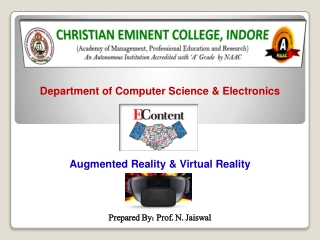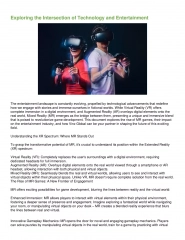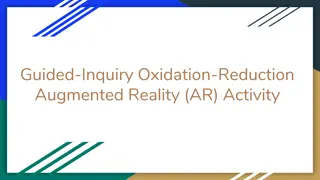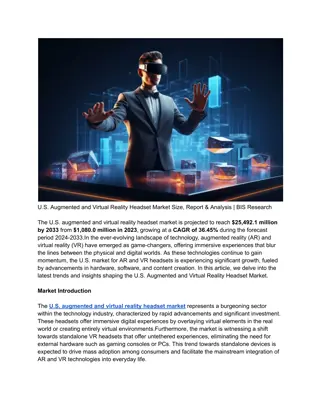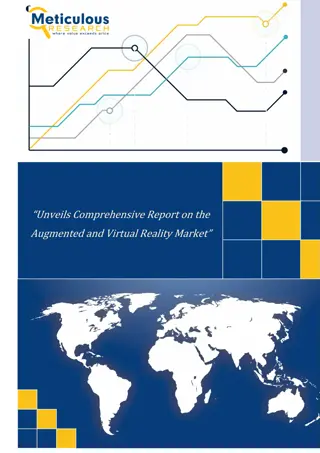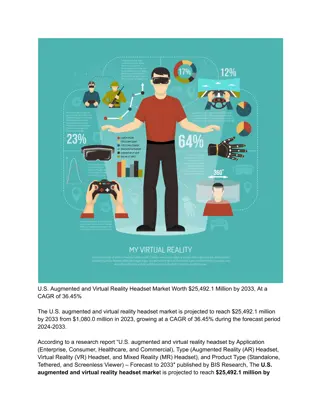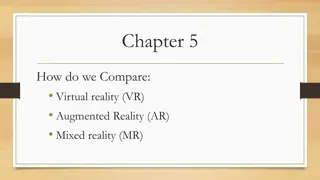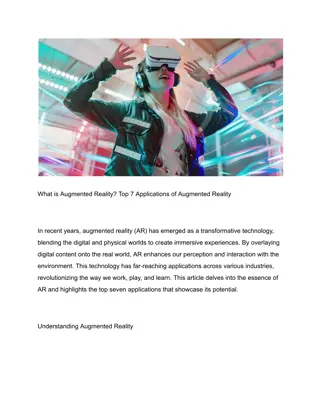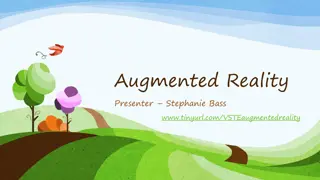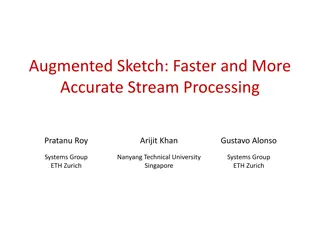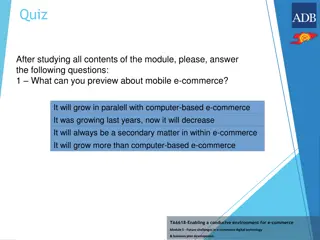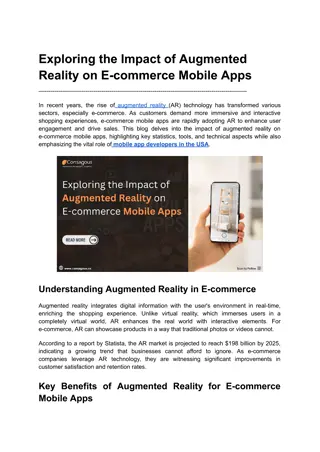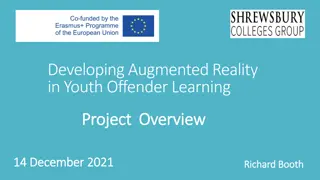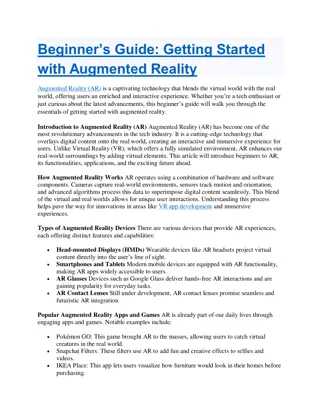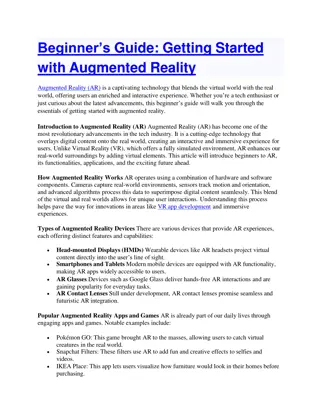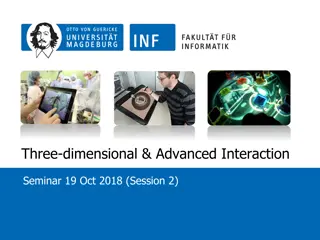Enhancing Student Engagement with Augmented Reality
Augmented reality (AR) technology is being increasingly adopted in educational settings to improve student engagement, interest, and motivation. This systematic review explores the advantages of AR in enhancing student learning experiences and provides insights into how AR technology facilitates student engagement. Research findings highlight the positive impact of AR on student interest, motivation, and self-confidence, ultimately leading to a more immersive and interactive learning environment.
Download Presentation

Please find below an Image/Link to download the presentation.
The content on the website is provided AS IS for your information and personal use only. It may not be sold, licensed, or shared on other websites without obtaining consent from the author.If you encounter any issues during the download, it is possible that the publisher has removed the file from their server.
You are allowed to download the files provided on this website for personal or commercial use, subject to the condition that they are used lawfully. All files are the property of their respective owners.
The content on the website is provided AS IS for your information and personal use only. It may not be sold, licensed, or shared on other websites without obtaining consent from the author.
E N D
Presentation Transcript
STUDENTS ENGAGEMENT USING AUGMENTED REALITY: A SYSTEMATIC REVIEW ROZA IBRAHIM GEETHA KANAPARAN ANDY SEDDON
AUGMENTED REALITY Augmented reality (AR) is an immersive technology that is gaining popularity among educational institutions. AR technology has been incorporated in education and higher education institutions due to its visual and interactive nature, to engage today s Z generation of students and to provide them with a comprehensive mechanism of teaching and learning (Dalim et al., 2017).
ADVANTAGES OF AR Authors (Guerrero et al.,2018) Advantages ofAR enhancing students interest and motivation in the subjects Karagozlu,(2018) (Guerrero et al.,2018) positively affects student s self confidence in solving problems. reduce participants accomplishment time (Sharif et al.,2018) opportunity to access and learn information in an exceptional way Karagozlu (2018), (Ferrer-Torregrosa 2015). (Fombona, Caldevilla, 2015) Sharif et al.(2018), (Guo et al.,2017) (Sirakaya Sirakaya,2018). students with different learning styles learn withAR enables self-control and self-study abilities in anatomy learning activities et al., Coto and Reduce error rate. AR makes academic process more playful teaching and learning activities more attractive observe and interact using a 3-dimensional approach and Alsancak (Saidin, Yahaya,2015) Abd Halim and immersive and realistic experiences provided byAR technology
RESEARCH QUESTION How does AR technology facilitate student s engagement?
ENGAGEMENT Engagement is as an essential component of learning caused by the learner s attention, interest and motivation. According to Wiseman, Kennedy and Lodge (2016), engagement is the active involvement and effort of students in educational activities which emphasizes cognitive, behavioral and emotional involvement. Thus, engagement and motivation are vital in order to achieve a goal (Yusoff and Dahlan, 2013) or to accomplish an educational objective. In order to engage students with the learning activities, technology can be used as a tool. In this context, engagement is described as student s association with the learning design and learning activities in a digital environment so that engagement is significant to researchers, instructors, educational technology designers and developers (Wiseman, Kennedy and Lodge, 2016). The researchers further highlighted the need of engagement to assist learning activities and developing support mechanisms around these tasks.
ENGAGEMENT Chen et al.(2017) AR deepens students engagement,improves students perceived enjoyment and positive attitude. AR has been effective in improving student s motivation and engagement. Bacca et al.(2014) Yusoff and Dahlan (2013) Saidin et al.(2015) AR can engage students with their learning AR features engage students in their learning and improve their visualization skills. further highlight that the positive feedback from participants indicate the willingness to actively engage in their studies throughAR tools. Teichner (2014) Karagozlu (2018) engages and retains students with their learning engagement with learning materials leading to better academic achievement
METHODOLOGY This study adopted the PRISMA protocol (Liberati et al., 2009) with best practice guidelines of Pahlevan Sharif, Mura and Wijesinghe, (2019). A protocol was developed with the purpose of the review, eligibility criteria data source and document the analysis method.
STUDY OBJECTIVES: To investigate how AR technology facilitate student s engagement. To study the features of AR technology that facilitate student s engagement in teaching and learning. To examine the instructional design methods, immersive visual features and interactive/collaborative experience used for engagement in AR aided environments.
ELIGIBILITY CRITERIA Inclusion Criteria Time Frame From 2013 to 2019 Study Focus Articles related to Augmented Reality and engagement in the context of higher education Language Studies published in English Literature Focus Studies focused on students engagement.
LITERATURE SEARCH: Literature search: ACM digital Library, Emerald Insight, IEEE and ProQuest. The search terms used were engaging students using AR technology , students engagement and AR technology . The search resulted in 122 articles which underwent a review of title and abstract.
THE FLOW DIAGRAM During the data extraction process: the articles were carefully read to extract and code the data focusing on the aim and objectives of the study. The information collected include authors, number of research participants, country of research, research objectives, methodology, data collection instrument, research findings, feature of AR technology to enhance engagement, instructional design methods used, visualization features embedded, interactive and collaborative experiences
RESULTS AR integrated in- biology, geometry, architecture, engineering, mathematics and museum studies and 40% of the studies are based on anatomy (a branch of biology). that the major concepts falls under three different categories; instructional design methods, immersive visualization and interactive/ collaborative features. There were 19 instructional design methods, 25 visualization features and 19 interactive and collaborative AR experiences embedded.
INSTRUCTIONAL DESIGN METHODS Instructional designing is a crucial aspect of digital technology when integrating AR in the teaching and learning process, to decide on how the pedagogy and technology will be combined in order to develop an effective learning environment. As stated by Guerrero et al. (2018), the interaction and motivation are highly satisfactory as combination of both pedagogy and technology. A review conducted by (Limbu et al., 2018) using sensors and augmented reality to train apprentices identified 18 instructional design methods. However, this study identified 19 instructional design methods which encompassed augmented contents such as 3D graphics, videos, animations, models, holographic interactive data, sounds and buttons for interactions. The instructional design methods comprise of augmented content such as 3D models, graphics, videos, animations and graphical user interface as commonly used instructional design approaches.
Author/s Article No 15 Instructional Design Methods (Guerrero et al., 2018) 3D graphic/objects, real objects, contents with videos, 3D images and interactive evaluations (Barraza et al., 2015) 19 a touch based graphical user interface (GUI) approach. plot a new graph according to the dimensions. (Ozarslan, 2016) Guti rrez de Rav 21 27 displays 3D objects, contents with videos self-explanatory icons, virtual buttons, geometric elements, real time feedback (Pollalis et al., 2018) 40 audio / visual/textual information, holographic representations voice commands, annotations on the original object, directional arrows to navigate from object to object. (S nchez et al., 2016) 44 a sand landscape as the main interface, real time 3D map, topographic map with contour lines, projects rivers, water, bodies of water with great detail and realism. audio, 3D model, phone paired with an electronic stethoscope, cloth imprinted AR tracking, audio data, real human body. (Moro et al., 2016) (See et al., 2016) 48 49 (Srivastava, 2016) 51 videos and voice instructions, cloth-based AR tracking, visual & audio cues, electronic stethoscope (Saenz et al., 2015) 53 physical skeletal model with AR targets, digital 3D model consisting of bones/ major muscles of the arm etc., graphical user interface videos and voice, virtual AR buttons, voice-based instructions, enquiry-based questions. (Vidal et al., 2016) 56 (Santos et al., 2013) (Rizov and Rizova, 2015) (Kurniawan et al., 2018) 63 67 73 3D model, contents with text/audio/video three-dimensional shape, model, video capturing, exercise 3D image visualization, interactive display the human body /body parts / organs. (Safadel and White, 2019) 78 3D presentation of macromolecules in PyMOL, drag and drop function in Adobe Captivate, interface of AR.
INTERACTIVITY AND COLLABORATION Azuma, (1997) describes interactivity in real time as a feature of AR while (Huisinga, 2017) defines AR as an experience which requires interaction. Also, (Nincarean et al., 2013; Vyas, 2015) found that AR facilitates user interaction and the interactive elements make the learning situation more dynamic (Yusoff and Dahlan, 2013). Also, Blum (2018), emphasizes that visual simulation and interactivity can make learning fun and enjoyable for students with low attention span. Additionally, AR can generate better interaction between students and teachers by motivating students with interesting explanations and assimilation of content. While explaining interaction in an AR environment, Munnerley et al., (2014), points out that users can view and interact with hidden images, communicate and collaborate with complex interactive environment. Also, students can manipulate the digital content by moving around after accessing the content, edit and change it (Huisinga, 2017). The researcher discusses the positives of this interactive learning experience as this allows learner to correlate an experience with new information, reinforces the ability to recall and retain the information. Further, the researcher states that the ability to change viewpoints in AR technology allows deeper examination of content and explained the concept by giving the example of an architectural student virtually walking through a building the student him/herself has designed or a chemistry student viewing a 3D model of a molecule from a different angle. Alternatively, Dey et al. (2016), refers interaction a very general area in AR.
COLLABORATION Collaboration is Another engaging aspect of AR technology. This is through the interaction with new environment, between students and between students and instructors (Chen et al., 2017; Sharif et al., 2018) provides satisfaction with learning experience (Sharif et al., 2018). This offers realistic learning experience, novel techniques, making learning process active effective and meaningful for the learners (Saidin et al., 2015). Also, this learner-centric approach of AR provides students the opportunity to construct new information based on the previous knowledge (Delello, McWhorter and Camp, 2015). A systematic review conducted by (Ak ay r and Ak ay r, 2017) on educational uses of AR found student interaction and collaborative opportunities as pedagogical contribution of AR. Also, the collaborative interface of AR enables synchronous collaboration of multiple stakeholders to be present and provide input at the same time (Irlitti et al., 2016). The researchers further explained that AR provides a three-dimensional environment and with registered information so that users can communicate and collaborate. Additionally, face-to-face collaboration is supported by speech, gaze, gestures and non-verbal cues to facilitate communication between the users. The physical environment and physical objects also assist in the spatial understanding and context facilitating communication and support thinking process. From the review it was found that there were diverse and multiple interactive and collaborative features implanted in AR applications (which are demonstrated in figure 3). The most commonly integrated interactive features including touch interface, panning and zooming and rotation navigation, intuitive interactions, voice and gesture recognition. Although the use of interactive tasks such as puzzles, games and questionnaires are also found in the literature, these tasks are not observed in this study, however, there were other interactive activities such as such as replotting equations in real time, drag and drop activities plus creating markers and scenes which are more engaging. Also, some studies used holographic interactive data, interactive virtual buttons, real time feedback, topography and graphical input. Additionally, the research on the AR sandbox with sand landscape as the main interface, could project topographic map with contour and students could actively experiment using this sandbox to projects rivers, waterbodies and terrains. It was also noted that users prefer more interactive and collaborative features to be available in the applications such as direct annotation, voice-based instructions and written answers of user converted to speech and display on the screen as pop up and also record interaction live. Likewise, it was noted that users also recommend having features that will allow creation mode or functionality so that they can create something new. Figure 3 displays the interactive and collaborative features of AR technology that engages students.
Interactive Collaborative Features Considering the interactive collaborative features, it was found that most of the AR environment consists of diverse and multiple interactive features such touch interface, panning, zooming and rotation navigation, voice and gesture recognition, intuitive interactions. 40% 33.30% interactive collaborative features It was found that 40% of the applications used 6 interactive features while 33.3% used 7 features and 13.3% used 8 interactive features. A very few researches (6.7%) used 5 features and also 6.7% used 3 interactive features. 13.30% 6.70% 6.70% 0 3 4 5 6 7 8
IMMERSIVE VISUALIZATION Immersive visualization is the main concept in AR and it is one of the main goals in transmitting the learning materials in order to engage the learner (Yusoff and Dahlan, 2013). The researchers also express that visualization using graphics and animation can be quite impressive and interactive and assists to construct mental models. The most commonly used visualization features found in this study consists of model rendering, augmentation, annotation, optical character recognition, text recognition, contextual and visualization features. Also, real world annotation, contextual visualization and vision haptic visualization are features that were observed. Some researchers have noted that AR features engage students in their learning by improving the visualization skills (Saidin et al., 2015) which Guti rrez de Rav et al., (2016) describes as a positive impact on student s spatial ability. This spatial ability with AR technology is an innovative and effective technique to engage students and provide them with an interactive and enjoyable experience (Guti rrez de Rav et al., 2016). The positive feedback received from the participants and documented in most studies indicates student s willingness to actively engage with their studies through AR. The figure 4 exhibits the features of AR technology that engages students with visualization.
AR Visualisation Features 40% The immersive visualization features include model rendering, augmentation, annotation, optical character recognition, text recognition, contextual and visualization and touch interface as frequently used features. 33.30% There were 25 visualization features observed and 40% of the studies used 8 features, 33.33% used 9 features 20% applications used 10 features and 6.7% used 4 features. It was found that there were different varieties of visuals used from model rendering to isosurface to topographic representation to real objects such as clothes, human body and sand interface. 20% 6.70% 4 8 9 10
CONCLUSION Augmented reality (AR) has been increasing and receiving attention from educational institutions. This is due to the technology s visual and interactive nature. Several researches have provided evidence that AR technology has motivated and engaged learners with visual and interactive features which made the learning process more active and effective. Since engagement is a crucial factor for learning, it is important to examine how AR technology facilitates student s engagement. This review systematically studied 15 researches from databases, ACM Digital Library, IEEE, ProQuest, and from other sources published from 2013 and examined the features of AR technology to facilitate student s engagement. It was found that AR technology incorporates instructional design methods, interactive and collaborative features and immersive visualization experiences to stimulate students with their learning. There were empirical evidences of 19 instructional design methods, 25 visualization features and 19 interactive and collaborative AR experiences entrenched in the AR applications. The study showed that diverse and multiple features in each category were integrated from touch interface, to panning zooming and rotation navigation, voice and gesture recognition, model rendering, contextual visualization, augmentation and annotation, optical character recognition, text recognition, are frequently used. Students preferred more interactive features and creative options to be included so that there is the possibility of creating new things by the students. It is expected that this study has revealed the importance of engagement in AR integrated learning environments and explained how the technology enhance student s engagement with learning activities. Also, it is anticipated that this study is beneficial for those integrating AR in educational institutions.


